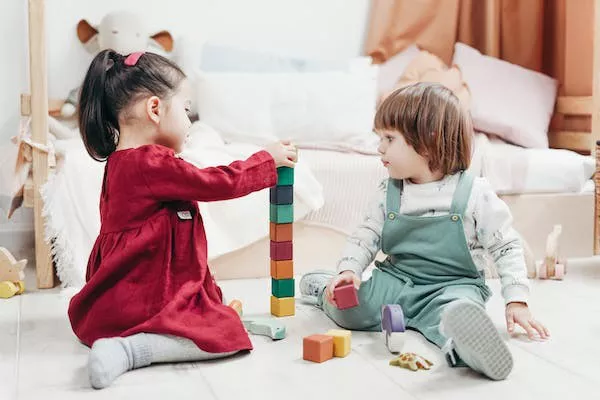Educational toys play a vital role in promoting cognitive, sensory, and motor development in infants. These toys are specifically designed to engage and stimulate young minds, fostering curiosity, exploration, and early learning. With numerous options available in the market, it can be overwhelming for parents to choose the best educational toys for their infants. In this article, we explore a range of educational toys that offer developmental benefits and provide a solid foundation for early learning. By understanding the features and benefits of these toys, parents can make informed choices that support their baby’s growth and cognitive development.
High Contrast Visual Toys: Stimulating Vision
High contrast visual toys, such as black and white board books or mobiles, are excellent choices for stimulating an infant’s developing vision. Infants have limited visual acuity during the early months, and high contrast patterns and shapes capture their attention and support visual tracking skills. These toys help in developing focus, enhancing visual perception, and laying the foundation for future visual exploration.
Sensory Toys: Engaging the Senses
Sensory toys provide infants with opportunities to explore and interact with different textures, sounds, and shapes, engaging multiple senses simultaneously. Soft fabric balls, textured blocks, or sensory play mats are examples of sensory toys that promote tactile and proprioceptive stimulation. These toys help infants develop sensory awareness, fine motor skills, and hand-eye coordination while providing a sensorial and interactive play experience.
Cause and Effect Toys: Encouraging Problem-Solving
Cause and effect toys, such as stacking rings or musical toys with buttons, introduce infants to the concept of cause and effect relationships. These toys encourage exploration and experimentation, as babies learn that their actions can produce specific outcomes. By pressing a button or placing a ring on a stack, infants begin to understand cause and effect, fostering problem-solving skills, hand-eye coordination, and cognitive development.
Shape Sorters and Stackers: Developing Spatial Awareness
Shape sorters and stackers are classic educational toys that promote spatial awareness, fine motor skills, and cognitive development. Infants learn to identify shapes, match them with corresponding holes, and stack objects in the correct order. These toys help develop hand-eye coordination, problem-solving skills, and an understanding of spatial relationships.
Musical Instruments: Stimulating Auditory Development
Musical instruments, such as shakers, xylophones, or baby drums, provide infants with opportunities to explore sound and rhythm. These toys stimulate auditory development, improve listening skills, and encourage sensory integration. Infants can experiment with different sounds, tones, and rhythms, promoting early musical appreciation and fostering cognitive and sensory development.
Nesting and Stacking Toys: Building Cognitive Skills
Nesting and stacking toys, such as nesting cups or stacking rings, offer infants the chance to explore size, spatial relationships, and sequencing. These toys enhance fine motor skills, hand-eye coordination, and cognitive abilities. Infants learn to differentiate sizes, understand concepts of big and small, and develop problem-solving skills as they stack or nest objects in the correct order.
Activity Gyms and Playmats: Promoting Exploration and Movement
Activity gyms and playmats provide a stimulating and safe environment for infants to explore and develop their motor skills. These toys typically include hanging toys, mirrors, and tactile elements to encourage reaching, grasping, and rolling. They promote sensory exploration, gross motor development, and visual tracking skills. Additionally, these toys offer opportunities for independent play, fostering a sense of curiosity and self-discovery.
Considerations for Choosing Educational Toys
When selecting educational toys for infants, several factors should be considered. These include age appropriateness, safety features, durability, and versatility. Toys that can be used in multiple ways or adapted to different stages of development offer more long-term value. Additionally, paying attention to materials, such as BPA-free plastics or non-toxic finishes, ensures the safety of the toys. Consider your baby’s individual interests and developmental needs, as well as your own preferences, when making a selection.
Conclusion
Choosing the best educational toys for infants is an important decision that can positively impact their early learning and development. High contrast visual toys, sensory toys, cause and effect toys, shape sorters and stackers, musical instruments, nesting and stacking toys, and activity gyms and playmats are all excellent options to consider. These toys promote cognitive, sensory, and motor skills, foster problem-solving abilities, and engage multiple senses. By providing infants with age-appropriate, safe, and stimulating toys, parents can create an enriching environment that supports their baby’s growth and cognitive development. Remember to observe your baby’s preferences, adaptability, and developmental milestones when selecting toys, and engage in interactive play experiences to further enhance the educational benefits. Through play and exploration, infants can embark on a journey of early learning, curiosity, and discovery that lays the foundation for lifelong intellectual growth.


